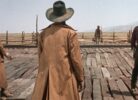To celebrate the upcoming release of my book, Akira Kurosawa: A Viewer’s Guide, due out Dec. 15 from Rowman & Littlefield — preorder here! — I’ll be doing capsule reviews all month covering every single Kurosawa film and posting (very) brief excerpts. These will be short impressions and recommendations, nothing more. For a full, detailed analysis of each, grab the book!
Rashomon (1950)
Reams upon reams have been written about Rashomon. It’s likely to be among the two or three Kurosawa films even casual film viewers have seen, or at least heard of, so for this capsule review series I won’t talk about it at length. I do in the book — it’s among the longest chapters — but when it comes to giving a quick recommendation, chances are you already know whether or not you should see this. (Spoiler alert: you should.)
For those who don’t know, Rashomon is the pioneering work by Akira Kurosawa that not only brought him to international acclaim, it also set new standards in non-linear storytelling, influenced directors like Quentin Tarantino and Martin Scorsese, and embedded itself so deeply into the popular subconscious that it’s even been referenced on The Simpsons.
The story is simple, on the surface: A woodcutter and a priest are witness to the trial of a bandit who attacked a husband and wife, killing the husband and raping the wife. However, the testimony reveals that every person involved has a starkly different recollection of events. Even after hearing all tell their tale, the truth of what took place remains murky. The end.
From the book:
There is no objective truth to be found here. We are told how these events played out, but because of the way the film is structured we cannot bear witness to them ourselves. We have to experience them second or third-hand. We are told what took place and must then sort out for ourselves what we choose to believe and what we do not. Like Citizen Kane a decade prior, we’re not sure just how much we should trust the story we’re being told. .
This is very much a movie about the nature of truth and what it says about ourselves. When the woodcutter laments, “I don’t understand my own soul,” it’s easy to understand why. One walks away if every human being is predisposed to lie.
With superb performances by Toshiro Mifune and Takashi Shimura holding things afloat, this hugely influential, gripping drama is a must-see for anyone even remotely interested in movies. If you like classic movies, SEE THIS. Period.
It’s an instructive take on layered storytelling, daring in more ways than one, and is just plain entertaining as hell. Fans have already seen it — see it again! — and those who haven’t should add it to their list ASAP. This is essential viewing and should be among the first few Kurosawa films you see.
Check out my upcoming book for a full analysis exploring this film’s ideas, themes, good points, and bad
You can get the movie in this excellent edition by Criterion.







